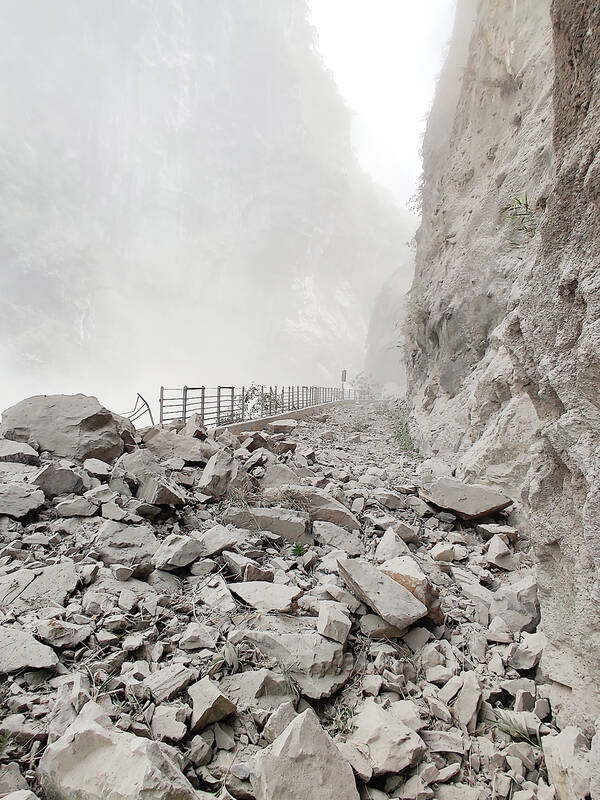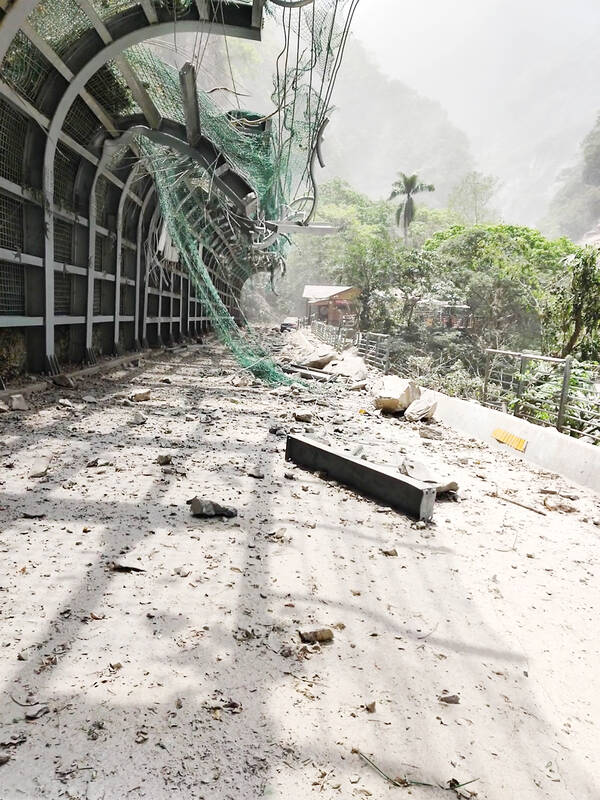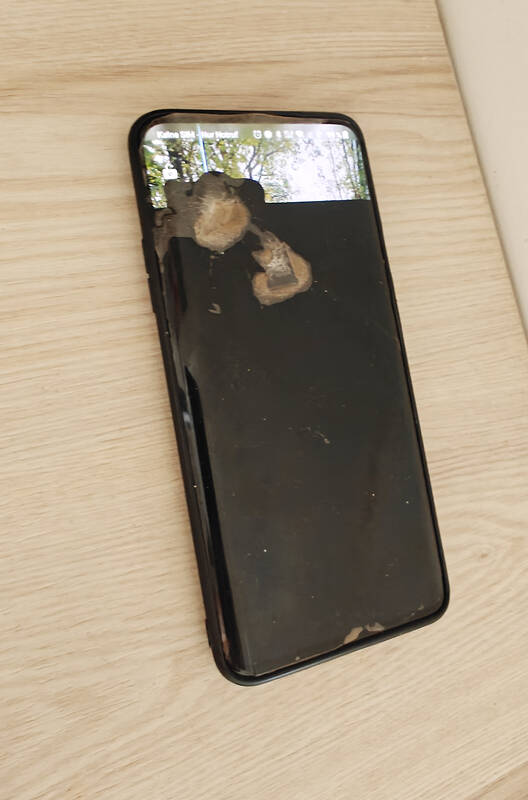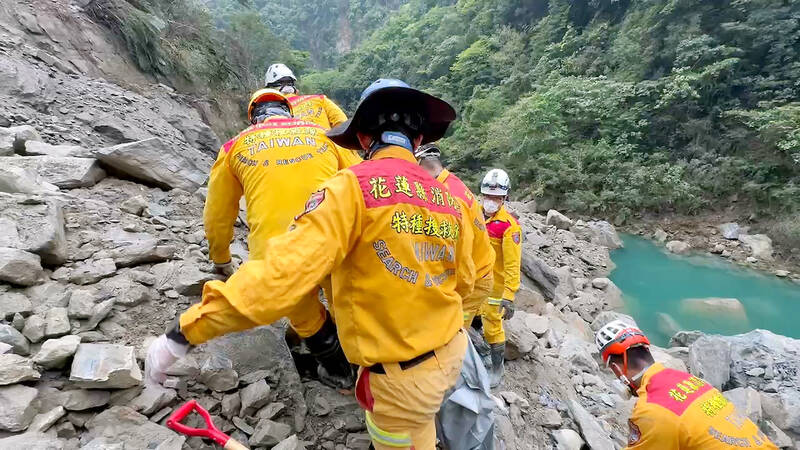Moritz Mieg, 22, lay face down in the rubble, the ground shaking violently beneath him. Boulders crashed down around him, some stones hitting his back.
“I just hoped that it would be one big hit and over, because I did not want to be hit nearly to death and then have to slowly die,” the student from Germany tells Taipei Times.
MORNING WALK

Photo courtesy: Moritz Mieg
Early on April 3, Mieg set out on a scenic hike through Taroko Gorge in Hualien County (花蓮). It was a fine day for it. Little did he know that the complex intersection of tectonic plates Taiwan sits upon were jarring.
Mieg had initially planned to hike the Shakadang Trail (砂卡噹步道). But at the last minute, the hostel owner suggested he start at Baiyang Trail (白楊步道) instead.
He parked his scooter at a small store near Jinheng Park (靳珩公園) and snapped a picture, timestamped at 7:55am. He then began hiking. But just minutes later, at 7:58am, the earthquake struck 50km northeast of where he was walking. The 7.2 magnitude quake was Taiwan’s strongest in 25 years. Taroko’s Shakadang Trail was hit particularly hard: five hikers lost their lives and two remain missing at the time of writing. The death toll currently stands at 17 and rescue missions are ongoing due to landslides and aftershocks.

Photo courtesy: Moritz Mieg
An exchange student studying at National Taiwan Normal University, Mieg had arrived in Taipei just two months before. Growing up in Europe, he’d never experienced anything like an earthquake, and found himself utterly unprepared.
Recalling his initial confusion, he remembers the alert vibrated his phone.
Immediately after, “I felt the earthquake and rocks falling down. Those two things happened at the same time in my memory. . . while running, I realized, yeah that’s why my phone was going crazy a second ago,” he says.

Photo courtesy: Moritz Mieg
A barrage of boulders and debris rained down on him. One sharp blow to his head left an open wound. He sustained multiple cuts and bruises on both legs and his face, bleeding from beneath his eyebrow, teeth and gums on one side.
Mieg sprinted for cover and threw himself flat along the side of a cliff face.
“I kind of hid my head under my arms and waited for it, the quake or my life, to be over.”

Photo by Hsu Sheng-lun, Taipei Times
Soon everything turned black.
“My first thoughts were that I am either buried under rocks or I’ve turned blind by the hit on my head.”
He then realized the rock fall had caused plumes of dust, blocking out the sunlight.

Photo courtesy: Chairman of Taroko Tongli Tribal Natural Ecology Autonomous Association
Mieg would wait for four and a half long hours, hiding from aftershocks in the darkness and screaming for help. On his smashed phone, only a small strip of screen remained visible, displaying the time. His SOS call failed in the signal blackout and he neither heard, nor saw any sign of other survivors on the devastated trail.Wrapping his head in a t-shirt to stem the bleeding, he feared the worst, put on a red jacket to aid rescuers in finding him.
FINDING A WAY OUT
Once the aftershocks dissipated and the dust had settled, Mieg knew he had to take his chances and try to find help. Motivated by his fear of being “back in the darkness” once the sun set, he began limping back towards the store where he’d parked his bike, not knowing if anyone there had survived, or the extent of his own injuries. To his relief, the store remained standing. Four workers and six tourists were taking refuge inside. One Swiss national had also sustained a severe head injury, was vomiting from a concussion and ultimately needed stitches.
The search and rescue team arrived at 11:30pm, and immediately escorted the group to hospital. Mieg did not return to his accommodation until 3am, almost 20 hours after he had left on that fateful morning walk.
His three travel companions at his Taroko hostel, as well as friends in Taipei, had been in communication with his desperately worried girlfriend and parents back home in Germany. Everyone was overwhelmed with relief when he finally made contact.
Today, weeks after the main earthquake, Mieg is still injured and struggles to walk on his right leg.
“Apart from that I feel surprisingly well,” he says.
He regularly calls home for emotional support, as the hundreds of aftershocks that have followed the original quake leave him anxious. However, he knows he had an incredibly lucky escape thanks, in part, to some quick thinking and gut instinct.
TRAVEL ADVICE
■ Currently both the Shakadang Trail and Baiyang Trail are temporarily closed due to earthquake damage. When they reopen, hikers should exercise extreme caution before considering a visit due to ongoing aftershocks and landslides.
■ If you should experience an earthquake in a rocky or mountainous areas, find a tunnel or some form of shelter to avoid falling rocks.
■ Water, snacks, a first aid kit and a flashlight are essential for all long hikes in earthquake prone Taiwan.
■ Inform friends and loved ones of your route before you depart and don’t go alone.
■ Check local information and official advice before setting out.

Following the shock complete failure of all the recall votes against Chinese Nationalist Party (KMT) lawmakers on July 26, pan-blue supporters and the Chinese Communist Party (CCP) were giddy with victory. A notable exception was KMT Chairman Eric Chu (朱立倫), who knew better. At a press conference on July 29, he bowed deeply in gratitude to the voters and said the recalls were “not about which party won or lost, but were a great victory for the Taiwanese voters.” The entire recall process was a disaster for both the KMT and the Democratic Progressive Party (DPP). The only bright spot for

Water management is one of the most powerful forces shaping modern Taiwan’s landscapes and politics. Many of Taiwan’s township and county boundaries are defined by watersheds. The current course of the mighty Jhuoshuei River (濁水溪) was largely established by Japanese embankment building during the 1918-1923 period. Taoyuan is dotted with ponds constructed by settlers from China during the Qing period. Countless local civic actions have been driven by opposition to water projects. Last week something like 2,600mm of rain fell on southern Taiwan in seven days, peaking at over 2,800mm in Duona (多納) in Kaohsiung’s Maolin District (茂林), according to

Aug. 11 to Aug. 17 Those who never heard of architect Hsiu Tse-lan (修澤蘭) must have seen her work — on the reverse of the NT$100 bill is the Yangmingshan Zhongshan Hall (陽明山中山樓). Then-president Chiang Kai-shek (蔣介石) reportedly hand-picked her for the job and gave her just 13 months to complete it in time for the centennial of Republic of China founder Sun Yat-sen’s birth on Nov. 12, 1966. Another landmark project is Garden City (花園新城) in New Taipei City’s Sindian District (新店) — Taiwan’s first mountainside planned community, which Hsiu initiated in 1968. She was involved in every stage, from selecting

As last month dawned, the Democratic Progressive Party (DPP) was in a good position. The recall campaigns had strong momentum, polling showed many Chinese Nationalist Party (KMT) lawmakers at risk of recall and even the KMT was bracing for losing seats while facing a tsunami of voter fraud investigations. Polling pointed to some of the recalls being a lock for victory. Though in most districts the majority was against recalling their lawmaker, among voters “definitely” planning to vote, there were double-digit margins in favor of recall in at least five districts, with three districts near or above 20 percent in